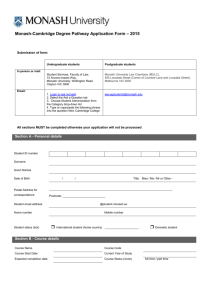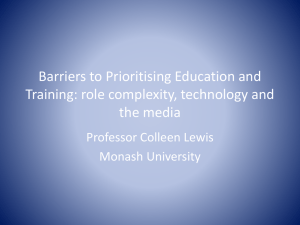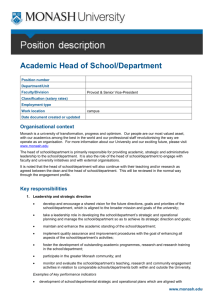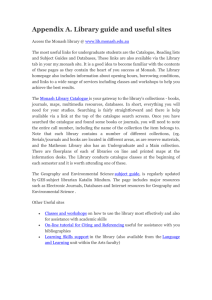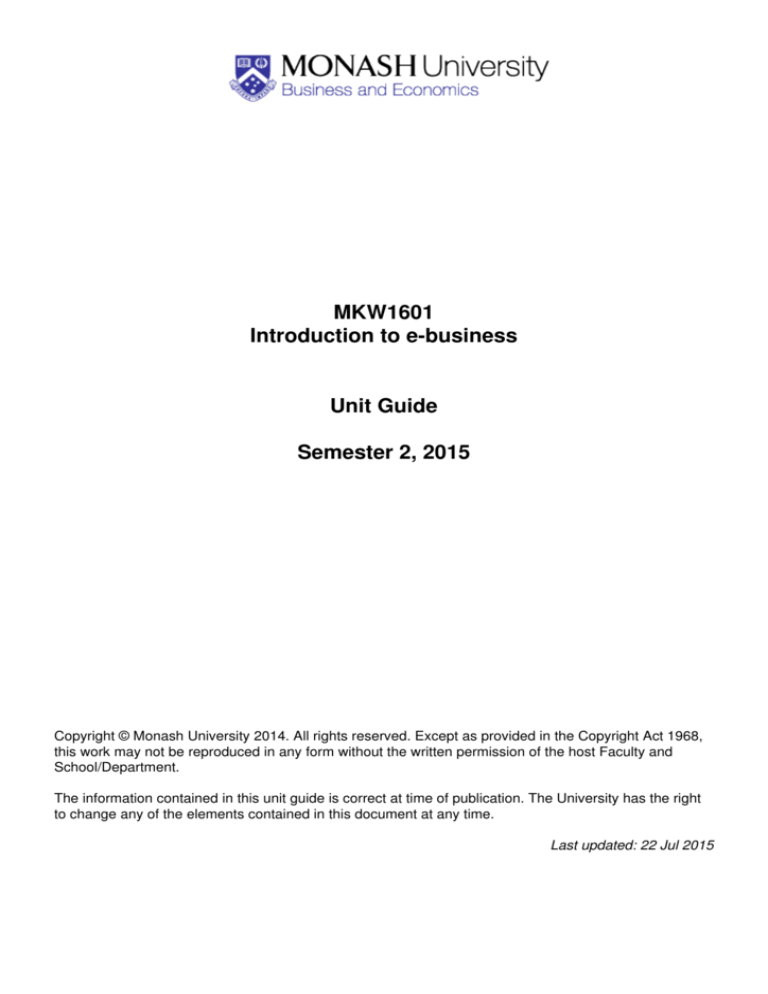
MKW1601
Introduction to e-business
Unit Guide
Semester 2, 2015
Copyright © Monash University 2014. All rights reserved. Except as provided in the Copyright Act 1968,
this work may not be reproduced in any form without the written permission of the host Faculty and
School/Department.
The information contained in this unit guide is correct at time of publication. The University has the right
to change any of the elements contained in this document at any time.
Last updated: 22 Jul 2015
Table of Contents
MKW1601 Introduction to e-business - Semester 2, 2015.....................................................................1
Mode of Delivery..............................................................................................................................1
Workload requirements....................................................................................................................1
Additional workload requirements........................................................................................1
Unit Relationships........................................................................................................................................1
Prohibitions......................................................................................................................................1
Chief Examiner(s)........................................................................................................................................1
Campus Lecturer(s).....................................................................................................................................1
Malaysia...........................................................................................................................................2
Tutor(s)........................................................................................................................................................2
Malaysia...........................................................................................................................................2
Your feedback to Us....................................................................................................................................2
Previous Student Evaluations of this Unit....................................................................................................2
Academic Overview...................................................................................................................................3
Learning Outcomes.........................................................................................................................3
Unit Schedule.............................................................................................................................................4
Teaching Approach..........................................................................................................................5
Assessment Summary.....................................................................................................................5
Hurdle Requirements...........................................................................................................5
Second marking...................................................................................................................6
Return of final marks............................................................................................................6
Exam viewing.......................................................................................................................6
Assessment criteria..............................................................................................................6
Assessment Requirements......................................................................................................................7
Assessment Tasks...........................................................................................................................7
Assessment task 1...............................................................................................................7
Assessment task 2...............................................................................................................9
Assessment task 3.............................................................................................................10
Examination(s)...........................................................................................................................................13
Examination 1................................................................................................................................13
Learning resources....................................................................................................................................13
Feedback to you........................................................................................................................................13
Assignment submission.............................................................................................................................13
Hard copy submission...................................................................................................................13
Online submission.........................................................................................................................14
Prescribed text(s) and readings.....................................................................................................14
Other Information....................................................................................................................................15
Policies..........................................................................................................................................15
Graduate Attributes Policy.................................................................................................15
Student Charter.........................................................................................................................................15
Student services........................................................................................................................................15
Monash University Library.........................................................................................................................15
Moodle 2....................................................................................................................................................16
Disability Liaison Unit................................................................................................................................16
MKW1601 Introduction to e-business - Semester 2, 2015
Introduction to e-business and its enabling technologies including email, EDI, EFT, bar-coding, electronic
catalogues, smart cards and CALS. Associated electronic processes and systems including on-line
business, the Internet and World Wide Web (WWW). Other issues include international standards,
ethics, privacy, accounting, legal and security issues; the impact on the workplace; corporate, national
and global information infrastructures; aligning information technology to business strategy; electronic
marketing worldwide; internationalisation, government policies, strategies and leadership.
Mode of Delivery
Malaysia (Day)
Workload requirements
Minimum total expected workload to achieve the learning outcomes for this unit is 144 hours per
semester typically comprising a mixture of scheduled learning activities and independent study.
Independent study may include associated readings, assessment and preparation for scheduled
activities. The unit requires on average three/four hours of scheduled activities per week. Scheduled
activities may include a combination of teacher directed learning, peer directed learning and online
engagement.
See also Unit timetable information
Additional workload requirements
ON-CAMPUS: This is a 6 point unit, which means there expectation of an average time commitment of 3
hours per week.
The total time commitment expected for this unit is 144 hours. In addition to the 36 hours of class contact
you should plan to spend an additional 108 hours during the semester in study for this unit. This includes
time spent in preparing for and completing assessment tasks, together with time spent in general study,
revision, and examination preparation.
Unit Relationships
Prohibitions
BEW1601
Chief Examiner(s)
Tan Choon Ling
Campus Lecturer(s)
1
MKW1601 Introduction to e-business - Semester 2, 2015
Malaysia
Paul H.P. Yeow; paul.yeow@monash.edu
Tutor(s)
Malaysia
Esther Seow, email: esther.seow@monash.edu
Your feedback to Us
Monash is committed to excellence in education and regularly seeks feedback from students, employers
and staff. One of the key formal ways students have to provide feedback is through the Student
Evaluation of Teaching and Units (SETU) survey. The University’s student evaluation policy requires that
every unit is evaluated each year. Students are strongly encouraged to complete the surveys. The
feedback is anonymous and provides the Faculty with evidence of aspects that students are satisfied
and areas for improvement.
For more information on Monash’s educational strategy, see:
www.monash.edu.au/about/monash-directions/ and on student evaluations, see:
www.policy.monash.edu/policy-bank/academic/education/quality/student-evaluation-policy.html
Previous Student Evaluations of this Unit
If you wish to view how previous students rated this unit, please go to
https://emuapps.monash.edu.au/unitevaluations/index.jsp
2
Academic Overview
Learning Outcomes
The learning goals associated with this unit are to:
1. define the purpose and scope of e-business
2. identify the technology that underpins e-business environment
3. examine the impact of marketing and strategy development in this environment
4. examine the impact of policy and the future of e-business.
3
Unit Schedule
Week
Activities
Assessment
0
View the Moodle website and look at the materials
available, as well as the weekly tutorial tasks.
No formal assessment or activities are
undertaken in week 0
1
Ch1: Overview of Electronic Commerce/Business
No tutorial in week 1
2
Ch2: EC Mechanisms, Infrastructure &Tools
Detailed discussion on the procedures
for tutorials, tutorial participation, and
expectations including discussion on the
presentation and group assignment.
3
Ch9: EC Security and Fraud Protection
Chapter 1 Questions for discussion: 1, 2,
5, 6, 7, & 8 page 73
4
Ch10: EC Payment Systems
Chapter 2 Questions for discussion: 1,
2,4,5,6, &12 page 127
5
Ch12: EC Strategy & Globalization
Chapter 9: Questions for discussion: 1,
2, 3, 4, 5, & 8 pages 541-542.
6
Ch3: Retailing in EC
Problem clinic: Discussion on group
assignment
7
Ch4: B2B EC
Chapter 10: Questions for discussion: 1,
2, 3, 4, & 5 page 574
8
Mid-term examinination
Chapter 12 Questions for discussion: 1,
3, 4, 6, 7, & 9 page 654
9
Ch6: Mobile Commerce
Groupon Pg. 64-65. Q1 & 2. Additional
question: Use Porter's Model (pg 620) to
analyse if Groupon will survive in the
long term.
10
Ch7: Social Commece
IKEA: Q2,3 &5 (pg175-176); Assessment
Task 1 Submission Deadline
11
Ch14: EC Regulatory, Ethical & Social Environment
Yuen et al. (2015) entitled 'Internet
banking acceptance in the United States
and Malaysia: a cross-cultural
examination', Marketing Intelligence &
Planning. Q1.Summarize the papers. Q2.
Why do you think there is a difference in
security need/preference between
developed and developing countries?
12
Unit Revision
Freemiums in the Social Gaming World.
Pg 576-577. Answer Q1, 2 & 4;
SWOT VAC
No formal assessment is undertaken
SWOT VAC
Examination period
LINK to Assessment Policy:
http://policy.monash.edu.au/policy-bank/
academic/education/assessment/
assessment-in-coursework-policy.html
4
Unit Schedule
Teaching Approach
Lecture and tutorials or problem classes
There will be a two hour lecture and a one hour tutorial each week. Tutorials will involve discussions of
prescribed readings and sample exam questions. It is an expectation in this unit that journal readings are
incorporated into all aspects of the unit assessment. The practice questions are from the prescribed text
book.
The unit will require at least nine hours per week in addition to the class contact hours in order to achieve
a pass grade. Some of this time will be spent searching and browsing the Internet, in a student lab or in
another location of the student’s choice. The teaching program will consist of lectures, class discussion,
and presentations. Students should expect to spend time each week reading books, academic journal
articles, newspapers, magazines, and research on the Internet.
Tutorial allocation
On-campus students must enrol themselves in a tutorial group using Allocate Plus i.e.
https://allocate.its.monash.edu.au/aplus/apstudent
Blackboard (MUSO)
The MUSO site for this unit is extremely important: it has lecture notes and other useful material. The site
can be accessed via your my.monash portal. It is strongly recommended that you visit the site on a
regular basis and before every tutorial in particular.
Assessment Summary
Within semester assessment: 50%
Examination: 50%
Assessment Task
Value
Due Date
Assignment (Report):
E-Business Research and
Analysis
20%
Friday of Week 10
(9 October 2015)
Mid Semester Examination
20%
During the lecture
of Week 8
Tutorial Participation
10%
Examination 1
50% of final unit mark. You must pass the exam
to pass the unit. See the Hurdle requirement
information.
To be advised
Hurdle Requirements
There is a hurdle requirement in this unit. Students must attempt all pieces of assessment tasks and
demonstrate a satisfactory level of achievement in each task with a view to receive a pass grade or any
higher grade.
The learning outcomes in this unit require students to demonstrate in the individual summative
assessment task a comprehensive understanding of the topics covered in the unit. This is demonstrated
5
Unit Schedule
by the requirement that the student must attain a mark of at least 50% in the final summative
assessment task. The individual summative assessment task is the final exam.
A student’s final mark is normally the sum of the marks obtained in all of the individual assessment items
in the unit. Where a student fails the unit solely because of failure to satisfy the hurdle requirement a
mark of 48 will be returned for the unit.
Second marking
Where an assessment task is given a fail grade by an examiner, that piece of work will be marked again
by a second examiner who will independently evaluate the work, and consult with the first marker. No
student will be awarded a fail grade for an assessment task or unit without a second examiner confirming
the result.
Note: Exceptions to this are individual pieces of assessment contributing 10% or less of the final mark,
unless the total of such pieces exceeds 30% of the final mark.
Return of final marks
Faculty policy states that 'the final mark that a student receives for a unit will be determined by the Board
of Examiners on the recommendation of the Chief Examiner taking into account all aspects of
assessment'.
The final mark for this unit will be released by the Board of Examiners on the date nominated in the
Faculty Calendar. Student results will be accessible through the my.monash portal.
Exam viewing
The faculty policy is available at:
http://www.buseco.monash.edu.au/esg/agu/policies/feedback-exam-performance.html
and the specific department arrangements for Marketing are detailed at:
http://www.buseco.monash.edu.au/mkt/student/exam-view/
Assessment criteria
Assessment Criteria Grading Descriptors available at:
http://www.policy.monash.edu/policy-bank/academic/education/assessment/
6
Assessment Requirements
Assessment Tasks
•
Assessment task 1
Title:
Assignment (Report): E-Business Research and Analysis
Due date:
Friday of Week 10 (9 October 2015)
Details of task:
Objective:
♦
To provide students an opportunity to the witness the implementation of the
e-business models learned from the unit in the real-world. This experience enables
students to see how theory can be put into practice.
Group Size:
Students will form a group of minimum 3 and maximum 4 to do the report. Group will be
formed on mutual agreement. Peer review form must be filled by each member to indicate
each group member contribution. Arbitration process will be carried up if evaluation is
contribution is below 6 of 10. Each group will have to do research and analysis on an
e-business system. The group needs to select a website/mobile application and is
required to discuss the selection with the tutor before starting the research.
Notes:
1. Please submit the membership form (on page 6) by Week 3 to your tutor.
2. All members are required to show their full participation in this assignment.
Non-participating member may be discharged from the group and will have to do
the whole assignment on his/her own.
3. Submit a hardcopy of the report (of 3,000 - 4,000 words, excluding tables,
references, appendices and figures) to the assignment box (located in building 6
level 5, left side of the entrance) on the 9 October (Friday) before 5 pm. All group
members are responsible to ensure that their name, student ID and tutor (Paul
Yeow, Tan Choon Ling or Esther Seow) are correctly stated in the cover page
and all members have signed it. Equal marks will only be given to names and
student IDs that appear on the cover page (except for arbitration cases).
Assignment Details:
Introduction:
You and your friends have just graduated and wanted to try a new e-business startup. To
reduce risk, your team has decided to copy ideas from an existing successful e-business.
The first step is to do reverse engineering of the successful e-business by deriving its
business plan. With this understanding, your team could later copy and modify the
business plan to suit a niche market. The successful e-business which you analyze could
be using various business models such e-tailing, social commerce, mobile commerce,
Freemium, crowdsourcing, etc. They may be serving various markets such as B2B, B2C,
B2G, C2C, or C2B.
7
Assessment Requirements
Criteria for marking:
Assignment 2: E-Business Plan (format and marks distribution – total 100 marks,
weighting 20%)
Market Gap Identification and Problem Statement
Mission Statement
Business Goals
Value Proposition
Business Model(s)/Implementation(s)
Target Market Analysis
Competitor Analysis
Opportunities and Threat Analysis, Competitive Advantage
Environmental Challenges Analysis
Total
5 marks
5 marks
5 marks
15 marks
20 marks
15 marks
10 marks
15 marks
10 marks
100 marks
Business Description:
- Identify the industry within which the e-business operate, analyse the market to identify
the gap, and what problem which the e-business wants to address. (5 marks)
- Find/derive the mission statement for the e-business. Include a paragraph or two that
explains or justifies the mission statement. This mission statement it should also be
complete and accurate enough to guide the formation of goals and the value proposition.
(5 marks)
- Find/derive two to three goals for the e-business. Each goal should include both a clear
statement of purpose and a brief explanation. (5 marks)
- Formulate and write the value proposition of the e-business. This should be a paragraph
or two that clearly states the benefits the business will offer to customers and justifies why
this is an important proposition for customers and in the marketplace. (15 marks)
- Business Model(s)/ Implementation(s): Select one or two business model(s) that
accurately describe the e-business activities. For each model, identify and describe it and
include the value proposition (as above), the product and services, the technologies used
and the revenue model in your description. (20 marks)
Market, Competitors and Ethical Analysis
- Identify and briefly describe one to three target markets for the e-business. Make sure
your markets are scoped correctly—not too broad and not too narrow. Your description
should include as many demographic, geographic, psychographic, culture and consumer
characteristics as possible. (15 marks)
- Identify one to three significant competitors. Critically analyse the websites, mobile
8
Assessment Requirements
applications (if available), and the e-business models of the identified competitors to
ascertain their strengths and weaknesses. If the e-business has no present direct
competitors, then you should analyse what are considered to be the past practices prior to
your e-business idea. (10 marks)
- Use opportunities-and-threats approach, the competitive-strategies approach, or both,
to identify at least one source of possible competitive advantage for the e-business. Write
this up so a reader of the e-business plan will understand how the e-business achieves
commercial success/heading to failure. (15 marks)
- Identify the possible any possible regulatory, ethical or social risks/challenges in the
business model (s) (10 marks)
Release dates:
2-3 weeks
Word limit:
3000 - 4000 words
Weighting/Value:
20%
Presentation requirements:
None
Estimated return date:
Learning objectives assessed:
This assignment assesses unit objectives 2 - 4.
Submission details:
On paper. Electronic lodgement is not acceptable.
Penalties for late lodgement:
A penalty of 5% of the mark allocated to this assessment task will be deducted for each
day (including weekends) that the assessment is late. Maximum deduction is 40% after
which the assignment will not be accepted.
Assessment coversheet:
Work submitted for assessment must be accompanied by a completed copy of the
Assignment cover sheet which has been signed by the student. No assignment will be
accepted or marked if it is not accompanied by a signed Assignment cover sheet.
In the case of a group assignment, each member of the group must complete, sign and
attach to the assignment a separate copy of the Assignment cover sheet.
•
Each group member must complete a peer review form.
Assessment task 2
Title:
Mid Semester Examination
Due date:
During the lecture of Week 8
Details of task:
The Mid Semester Examination will be held during lecture hours, which consists of 10
minutes reading time and 60 minutes writing time.
This exam will consist of 60 multiple choice questions and will cover topics from chapters
1, 2, 9, 10, and 12.
Weighting/Value:
20%
Presentation requirements:
9
Assessment Requirements
•
None
Estimated return date:
Learning objectives assessed:
This exam assesses unit objectives 1 - 3.
Assessment task 3
Title:
Tutorial Participation
Due date:
Details of task:
Participation
Total Participation Marks = 10%
5% Tutorial Presentation; 2% Tutorial Discussion and 3% Individual Lecture and Tutorial
Participations. Your active participation would enable you to score full marks on this
assessment component.
Schedule
Week and Assignment
Allocated
Group
Week 3: Chapter 1 Questions for discussion: 1, 2, 5, 6, 7, & 8 Group 1
page 73
Week 4: Chapter 2 Questions for discussion: 1, 2,4,5,6, &12 Group 2
page 127
Week 5: Chapter 9: Questions for discussion: 1, 2, 3, 4, 5, & 8 Group 3
pages 541-542.
Week 6: Problem clinic: Discussion on group assignment
Week 7: Chapter 10: Questions for discussion: 1, 2, 3, 4, & 5 Group 4
page 574
Week 8: Chapter 12 Questions for discussion: 1, 3, 4, 6, 7, & Group 5
9 page 654
Week 9: Groupon Pg. 64-65. Q1 & 2. Additional question: Use Group 6
Porter's Model (pg 620) to analyse if Groupon will survive in
the long term.
Week 10: IKEA: Q2,3 &5 (pg175-176)
Group 7
Week 11: Yuen et al. (2015) entitled 'Internet banking
Group 8
acceptance in the United States and Malaysia: a
cross-cultural examination', Marketing Intelligence & Planning.
Q1.Summarize the papers. Q2. Why do you think there is a
difference in security need/preference between developed
and developing countries?
Week 12: Freemiums in the Social Gaming World. Pg
Group 9
576-577. Answer Q1, 2 & 4
Discussant
Group
Group 9
Group 8
Group 7
Group 6
Group 1
Group 2
Group 4
Group 3
Group 5
Weighting/Value:
10%
Presentation requirements:
10
Assessment Requirements
Participation
Total Participation Marks = 10%
5% Tutorial Presentation; 2% Tutorial Discussion and 3% Individual Lecture and Tutorial
Participations.
Tutorial Presenter
(Group)
An allocated group will be assigned randomly to present the tutorial answers for a certain
week. Include relevant sources (not limited to textbook) from the Internet,
journal/conference articles, books, magazines, etc. You are encouraged to seek
consultation from your tutor. Give a 30-minute presentation during tutorial (starting Week
3). The group who presents will take the leading role on that particular week’s tutorial
activities. The group will decide on how the summary will be presented and the questions
will be answered. The group is responsible in making the tutorial session functional,
stimulating, exciting, interesting, and enjoyable.
Tutorial Discussant
(Group)
A discussant group will contribute extensively to the tutorial discussion. The group will
prepare at least 5 questions and point form answers to be submitted to tutor. During
the class, the questions will be asked and answers will be given. In addition, if any
important point or issue is missed out by the presenter or additional points needed to be
covered, members of this group will step in. This group will be responsible in giving
constructive feedback on the activities of the day.
Timing
Maximum tutorial presentation time for the allocated group: 30 minutes
Maximum tutorial discussion time for the discussant group: 10 minutes
Maximum tutorial discussion time for other participants: 10 minutes
Last 10 minutes: Feedback from tutor
Estimated return date:
Criteria for marking:
Participation Marks Allocations (Total 10%)
Two criteria of the evaluation of the presentation (5%):
Presentation Content and Clarity:
HD
D
C
P
F
Highly developed Well-developed
Good skills in
Adequate skills Inadequate skills
skills in
skills in expression expression and in expression
in expression
11
Assessment Requirements
expression and
presentation.
and presentation.
Handling Question:
HD
D
Demonstrates
Evidence of
imagination or flair. imagination or
flair.
Demonstrates
originality and
Evidence of
independent
originality and
thought
independent
thought
presentation.
and
presentation
C
Well-reasoned
argument based on
broad evidence
and
presentation.
P
Sound
argument
based on
evidence
F
Very little
evidence of
ability to
construct
coherent
argument
Three criteria of the evaluation of the discussant (2%):
Questions asked:
HD
D
C
Highly developed Well-developed skills Good skills in
skills in
in expression.
expression.
expression.
Answers provided:
HD
Demonstrates
imagination or flair.
Demonstrates
originality and
independent thought
D
Evidence of
imagination or flair.
Evidence of
originality and
independent
thought
P
Adequate skills
in expression.
C
Well-reasoned
argument based
on broad evidence
Follow-up questions asked:
HD
D
C
Highly developed Well-developed skills Good skills in
skills in
in expression.
expression.
expression.
P
Sound
argument
based on
evidence
P
Adequate skills
in expression.
F
Inadequate
skills in
expression.
F
Very little
evidence of
ability to
construct
coherent
argument
F
Inadequate
skills in
expression.
Individual Lecture and Tutorial Participation (3%)
3 marks will be allocated for 9 times participations (with reasonably suitable answers).
Write yours and your tutor’s name in the participation ticket given.
Learning objectives assessed:
This series of presentations assesses unit objectives 1 - 4.
12
Assessment Requirements
Examination(s)
• Examination 1
Weighting:
50% of final unit mark. You must pass the exam to pass the unit. See the Hurdle
requirement information.
Length:
3 hours
Type (open/closed book):
Closed book
Hurdle requirements:
As noted earlier, the learning outcomes in this unit require students to demonstrate in the
individual summative assessment task a comprehensive understanding of the topics
covered in the unit. This is demonstrated by the requirement that the student must attain a
mark of at least 50% in the final summative assessment task.
The individual summative assessment task is the final exam.
A student’s final mark is normally the sum of the marks obtained in all of the individual
assessment items in the unit. Where a student fails the unit solely because of failure to
satisfy the hurdle requirement a mark of 48 will be returned for the unit.
Electronic devices allowed in the exam:
None
Learning resources
Monash Library Unit Reading List (if applicable to the unit)
http://readinglists.lib.monash.edu/index.html
Feedback to you
Types of feedback you can expect to receive in this unit are:
• Graded assignments with comments
• Test results and feedback
• Solutions to tutes, labs and assignments
Assignment submission
Hard copy submission
You will be advised on where to submit your assignment at the appropriate time.
13
Assessment Requirements
Online submission
If Electronic Submission has been approved for your unit, please submit your work via the learning
system for this unit, which you can access via links in the my.monash portal.
Prescribed text(s) and readings
Turban, E., King, D., Lee, J., Liang, T.P. and Turban, D. (2012) Electronic Commerce 2012: A
Managerial Perspective. 7th Global Edition. Pearson.
Or
Turban, E., King, D., Lee, J., Liang, T.P. and Turban, D. (2015) Electronic Commerce: A Managerial and
Social Networks Perspective. 8th Edition. Springer
(Expensive Version)
14
Other Information
Policies
Monash has educational policies, procedures and guidelines, which are designed to ensure that staff and
students are aware of the University’s academic standards, and to provide advice on how they might
uphold them. You can find Monash’s Education Policies at:
www.policy.monash.edu.au/policy-bank/academic/education/index.html
Key educational policies include:
• Student Academic Integrity Policy and Student Academic Integrity: Managing Plagiarism and
Collusion Procedures ;
• Assessment in Coursework Programs;
• Special Consideration;
• Grading Scale;
• Discipline: Student Policy;
• Academic Calendar and Semesters;
• Orientation and Transition; and
• Academic and Administrative Complaints and Grievances Policy.
Graduate Attributes Policy
http://www.policy.monash.edu/policy-bank/academic/
education/management/monash-graduate-attributes-policy.html
Student Charter
www.opq.monash.edu.au/ep/student-charter/monash-university-student-charter.html
Student services
The University provides many different kinds of support services for you. Contact your tutor if you need
advice and see the range of services available at http://www.monash.edu.au/students
You can also access important information from the Faculty of Business and Economics current students
page http://www.buseco.monash.edu.au/student/
Caulfield and Clayton students wishing to further develop English language skills in a fun group
environment can join a Conversational English Program. You can access these programs at
http://www.monash.edu/students/conversational-english/
Monash University Library
The Monash University Library provides a range of services, resources and programs that enable you to
save time and be more effective in your learning and research. Go to www.lib.monash.edu.au or the
library tab in my.monash portal for more information.
15
Other Information
Moodle 2
All unit and lecture materials, plus other information of importance to students, are available through the
virtual learning environment Moodle site. You can access Moodle via the my.monash portal.
Where to go for help
If you're stuck, confused or simply not sure how to approach Moodle, there are a number of Moodle
resources that you can tap into.
Disability Liaison Unit
Students who have a disability or medical condition are welcome to contact the Disability Liaison Unit to
discuss academic support services. Disability Liaison Officers (DLOs) visit all Victorian campuses on a
regular basis.
• Website: http://www.monash.edu/equity-diversity/disability/index.html
• Telephone: 03 9905 5704 to book an appointment with a DLO;
• Email: dlu@monash.edu
• Drop In: Equity and Diversity Centre, Level 1, Building 55, Clayton Campus.
16


